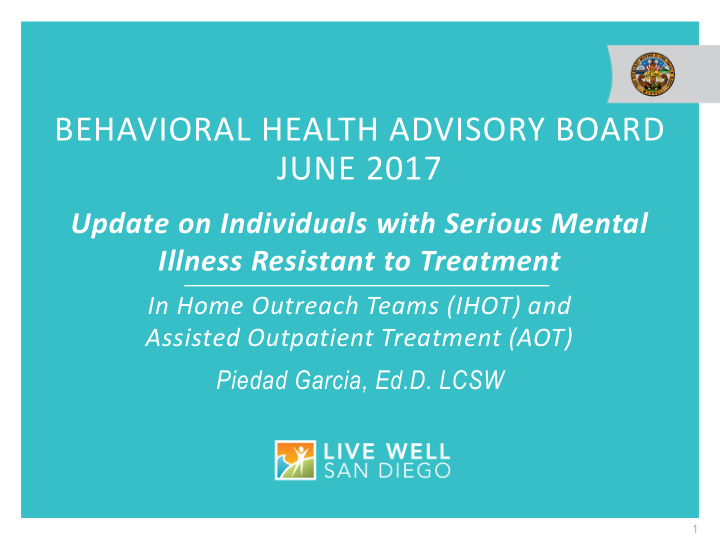



BEHAVIORAL HEALTH ADVISORY BOARD JUNE 2017 Update on Individuals with Serious Mental Illness Resistant to Treatment In Home Outreach Teams (IHOT) and Assisted Outpatient Treatment (AOT) Piedad Garcia, Ed.D. LCSW 1
IN HOME OUTREACH TEAMS (IHOT): UNDERSTANDING THE PROCESS OF INDIVIDUALS IDENTIFIED AS LAURA’S LAW CANDIDATES IHOT Teams: ⁻ 2 contracted providers serve all six HHSA regions. ⁻ Referrals are received from families, Homeless Outreach Teams, Law Enforcement, hospitals, PERT, jails, etc. ⁻ Teams include a licensed clinician, case manager, Family Support Specialist, and Peer Support Specialist. ⁻ Outreach and engage individuals resistant to treatment. ⁻ Determine if individual is a Potential Laura’s Law candidate (appears to meet all 9 criteria for Assisted Outpatient Treatment). 2
IHOT DEMOGRAPHICS FY16/17 (7/1/16-12/31/16) HHSA Region 7/1/16-12/31/16 N % Central 67 22.3 East 37 12.3 South 28 9.3 North Coastal 67 22.3 Living Situation 7/1/16-12/31/16 N % North Central 41 13.6 Lives with Family 135 44.9 North Inland 61 20.3 Homeless/Shelter 83 27.6 Lives alone 53 17.6 Total 301 100 Lives with non-relatives 24 8.0 Jail/Justice Related 3 1.0 Board and Care 2 0.7 Institutional/ Residential 1 0.3 Treatment Other 0 0.0 Total 301 100 3
CHARACTERISTICS OF IHOT PARTICIPANTS Substance Abuse, Hospitalization, and/or Incarceration* (Fiscal Year To Date; n=301) 100% 80% 60% 40% n=168; 55.8% n=156; 51.8% 20% n=84; 27.9% 0% Substance Abuse Psychiatric Hosp. (1 or more Incarceration (1 or more in in prior 12 mos.) prior 12 mos.) 4
IHOT PROGRAM STATUS 7/1/16-12/31/16 IHOT Program Status (n=485) Other Closed Active Outreach (n=189; 39.0%) (n=127; 26.2%) Active Engaged Linked to AOT- (n=63; 13.0%) Equivalent Services (n=13; Successfully 2.7%) Successfully Linked via IHOT Linked: Indirect (n=72; 14.8%) (n=21; 4.3%) 5
IHOT KEY OUTCOMES 7/1/16-12/31/16 IHOT Key Outcomes # of individuals 1 Referred individuals accepted into IHOT 301 2 IHOT participants who appeared to meet all nine criteria for AOT, defined as Potential Laura’s Law (PLL) 119 candidates (approximately 40% of participants) 3 PLL candidates successfully linked to appropriate 22 services and closed from IHOT program 4 PLL candidates requiring a higher level of care (i.e. 2 conservatorship, hospitalization, etc.) 5 PLL candidates closed from IHOT program for other reasons including: unable to locate, moved out of 35 county, ineligible for services, etc. 6 PLL candidates referred to AOT Clinician for a formal, 60 face-to- face evaluation of Laura’s Law eligibility 6
SERVICE UTILIZATION OUTPATIENT VISITS Total Visits: Total outpatient visits increased by 63.7% (650 visits pre- IHOT and 1,064 visits post-IHOT) 40% 35% 30% 25% 19.6% 20% 14.3% 15% 10% 5% 0% At Least 5 Outpatient Visits* (e.g., Outpatient, Case Mgmt., & ACT) 7
SERVICE UTILIZATION PERT, EPU, INPATIENT ADMISSIONS Total Visits: Total PERT visits decreased by 67.8% (93 visits pre-IHOT, 30 visits post-IHOT) Total Visits: Total EPU/Crisis visits decreased by 70.5% (44 visits pre-IHOT, 13 visits post-IHOT) Total Admissions: Total inpatient admissions decreased by 49.2% (61 admissions pre-IHOT & 31 admissions post-IHOT 40% 35.1% 35% 30% 25% 20% 15.1% 12.8% 15% 9.1% 10% 6.0% 2.6% 5% 0% At Least 1 PERT Visit At Least 1 Crisis Visit At Least 1 Inpatient Admit Pre-IHOT Post-IHOT 8
UNDERSTANDING AOT/LAURA’S LAW - Laura’s Law/Assisted Outpatient Treatment (AOT), or treatment mandated by court-order, is a process by which individuals with SMI, who are resistant to treatment, and meet nine criteria (pursuant to WIC 5345-5349.5), may be court ordered for treatment. - AOT is regarded as a last resort after numerous attempts to engage and link the individual to services have been unsuccessful. 9
REFERRALS TO AOT - IHOT is the starting point of a treatment continuum with the goal of linking and connecting individuals with SMI to appropriate treatment, and, if eligible referring to AOT. • If, after several attempts at engagement, an individual remains resistant to treatment and appears to meet criteria for AOT, they are referred to the AOT clinician for a face to face evaluation. • The face to face evaluation seeks to determine if the path to court-ordered treatment via AOT is appropriate. 10
TWO PATHS TO AOT • If the participant appears to meet AOT criteria , there are two paths for entering the program: 1. The individual is provided with the opportunity to participate in the AOT program as a voluntary participant with no court involvement. 2.The individual refuses voluntary participation and a petition is initiated to court order the individual into the AOT program. This petition may result in a settlement agreement, court order, or dismissal. 11
AOT PROGRAM SERVICES − AOT is a Full Service Partnership (FSP), Assertive Community Treatment (ACT). − Continuum of services to include recovery and wellness services along with psychiatric care. − Focus on preventing decompensation and cycling through acute services (psychiatric hospitalization, incarceration, etc.). − Highly collaborative, field-based teams provide intensive services. 12
AOT KEY OUTCOMES 7/1/16-12/31/16 AOT Key Outcomes # of individuals 7/1/16 – 12/31/16 1 Number of clients who met criteria under Laura’s Law and were accepted into the AOT program 33 2 Number of clients who voluntarily accepted treatment in the AOT program 17 3 Number of petitions filed for individuals who refused 0 voluntary services 4 Number of clients who are still in process (i.e. seeking voluntary acceptance post-evaluation, etc.) or discontinued 16 for other reasons (i.e. unable to locate) 5 Number of individuals who were court-ordered into treatment 0 13
NEXT STEPS • Resources were reallocated from AOT to IHOT effective 4/1/16. • Additional enhancements include: - Clinical assessment within 72 hours for high risk clients discharging from hospital or crisis centers. - Staffing to support engagement process. 14
Thank you!! Questions or Concerns? 15
Recommend
More recommend